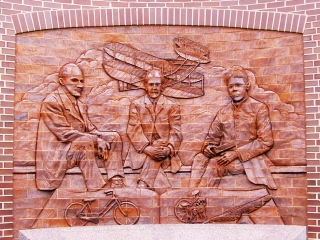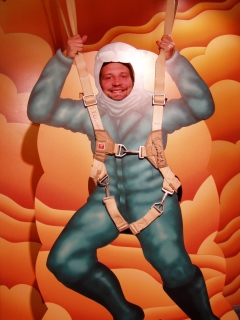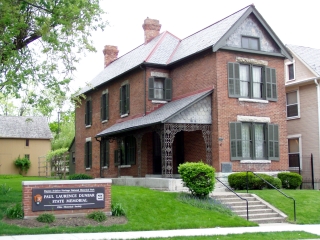Dayton Aviation National Historical Park
Dayton, Ohio
Visited: May 7, 2004
NPS Site Visited: 38 of 353
NPS Website; Local Website; Carillon Park Website; Dunbar Website
 WHAT IS IT? WHAT IS IT?
Five different sites located throughout the city of Dayton, Ohio that commemorate the early development and history of aviation as well as the life of African American poet Paul Laurence Dunbar.
BEAUTY (2/10)
The most striking part of the park is the Huffman Flying Field, the same test field where the Wright Brothers taught themselves how to fly and maneuver a plane. It is the world’s first airport. The path of the first sustained and circular flight is kept mowed. One can walk the course and easily imagine the delicate new flying machine above. It is a powerful place, but it is still just an open meadow surrounded by the working Wright-Patterson Air Force Base, thus the barb-wired fences and airplane hangars.
As far as the rest of the park, Dayton is not the midwest’s most attractive city. The Wright Cycle Company and the Dunbar House are two non-descript brick buildings. Their historical significance may have saved them from demolition. The forgettable Huffman Prairie Flying Field Interpretive Center does not stand out among the Air Force’s dull administrative buildings.
HISTORIC SIGNIFICANCE (9/10)
Flight was born here. The Kitty Hawk, N.C. flight receives the most notoriety but we were taught in Dayton that those flights were little more than advanced gliding. The North Carolina flights were not self-propelled, were only straight ahead and in controlled conditions. Not only did all the design, construction, and ingenuity happen in Dayton; all the real flight occurred here too.
The aviation innovation did not stop with the Wright Brothers. Nearly every new American military plane has been designed and tested primarily at Wright-Patterson Air Force Base.
The Site also celebrates poet Paul Laurence Dunbar, who, sadly, we knew nothing about before we arrived. This high school colleague of Orville and Wilbur was a published poet by the time he was a teen. He was known for writing in two very distinct styles – one formal and in dialect. Most Harlem Renaissance writers credit him as an influence. His most familiar poem is I Know Why the Caged Bird Sings.
The Dunbar House was the first state memorial dedicated to an African American.
CROWDS (4/10)
There weren’t many people at any of the sites.
 EASE OF USE/ACCESS (2/5) EASE OF USE/ACCESS (2/5)
There are five separate sites. The National Park Service provides wonderful directions to each site and seems to have placed a brown directional sign at nearly every intersection in Dayton. Still, driving from place to place can make for a long and hectic day. The sheer amount of places and information thrown at the visitor parlays a prolonged feeling of unease.
The National Park Service does not administer the Wright Brothers Aviation Center or the Paul Dunbar State Memorial; both purported to be a part of the National Historical Park. In addition one cannot enter the Wright Brothers Aviation Center without purchasing a ticket for the Carillon Historical Park, a multi-reconstructed building living history museum that happens to also include the Aviation Center.
The Wright Brothers Cycle Shop was scheduled to be open in the spring of 2004 but it is still under renovations.
CONCESSIONS/BOOKSTORE (5/5)
Four of the five sites along the Aviation Heritage Trail had bookstores. All four had spectacular selections especially, the Wright-Dunbar Interpretive Center (part of the Wright Cycle Shop Complex) and the Huffman Prairie Flying Field Interpretive Center. There were numerous books on aviation’s history, scientific principles and legend. There were airplane models, posters, Wright Brothers (and sister) dolls and knickknacks like you wouldn’t believe.
The Wright-Dunbar Store had a unique selection of books related to African American poets, writers and heritage sites. Actually, the best we have seen so far. African American sites and subjects received equal billing at the Wright-Dunbar Store.
COSTS (2/5)
The Huffman Prairie Flying Field and its Interpretive Center are free as is the Wright Brothers Cycle Center and its accompanying Visitor Center/Museum.
The Paul Laurence Dunbar State Memorial cost $5 per adult. We asked if there was any National Parks Pass Discount and the fair response was that they receive no money from the National Parks System so they have to charge. We understood.
The Carillon Historical Park, on the other hand, did not seem to realize that they were a part of the National Park System. Repeated inquiries about the Parks Pass, the NPS Passport Stamp, and entry into only the Aviation Center were met with a deaf ear and a rude rebuff. Their entry price was $5 per adult.
RANGER/GUIDE TO TOURIST RATIO (2/5)
There were a few at the NPS sites, the Wright-Dunbar Interpretive Center and the Huffman Prairie Interpretive Center, but none inspired confidence with their answers to our questions. The museums are both new and designed to be completely self-guided. The Rangers don’t even try to help.
The Huffman Prairie Museum is also testing a new encyclopedia-ish palm pilot contraption that aims to answer every aviation related question the visitor may have. Instead, it confuses and distracts the visitor from the actual exhibits. We hope that these palm pilots don’t catch on. Human Rangers are sooooooooooooo much better. If anyone from the Park System is reading this, please stop the madness.
TOURS/CLASSES (7/10)
The museums were great. The palm pilots were horrible. Without the mini-computers and the Ranger purge that they insidiously promise, this rating would have been higher.
 FUN (6/10) FUN (6/10)
We had a good time at all of the sites, save the Carillon Historical Park. Some kind of public transport from site to site would have been nice. The cross-city driving and directional worries definitely dropped the fun levels. Perhaps a trolley path would also frame the park a little better.
There were so many NPS sites, non-NPS sites and sites whose connection to the Aviation Trail we did not initially understand (the Paul Laurence Dunbar Site). It took 15 minutes to figure out where we were going.
WOULD WE RECOMMEND? (5/10)
If you are a flight buff then you owe it to yourself to come to Dayton. The National Parks Site museums are excellent if not far apart. You can see the 1905 Wright Flyer III, the plane that made the first self-propelled flight, at the Carillon Historical Park. It was restored by Orville Wright, himself. You can walk the hallowed grounds of Huffman Flying Field while our modern Air Force planes scream and roar overhead. There are at least seven other aviation related non-NPS sites in Dayton, including the National Aviation Hall of Fame and the United States Air Force Museum. You could easily spend a couple days here.
If you live nearby or are in Dayton, you should go to either the Huffman Prairie Flying Field or the Wright Cycle Company Complex. Their museums are both superb. If we had to choose, we’d pick the Flying Field.
TOTAL 44/80
|